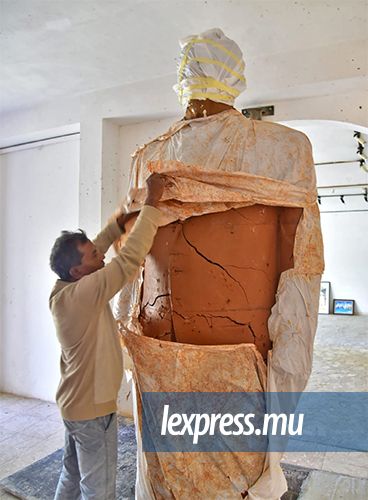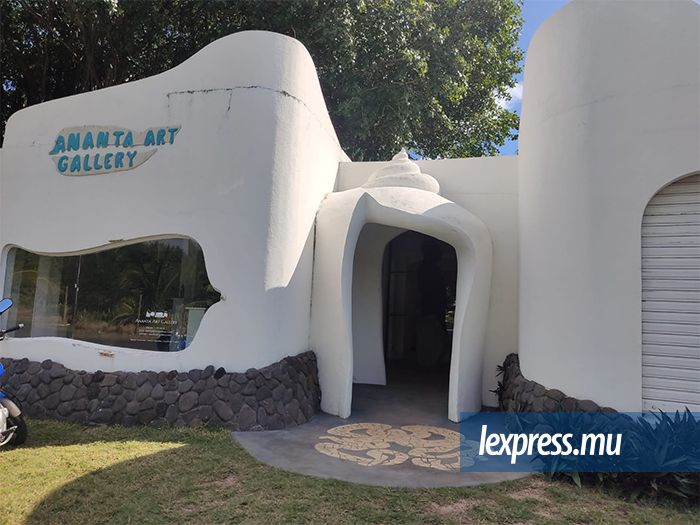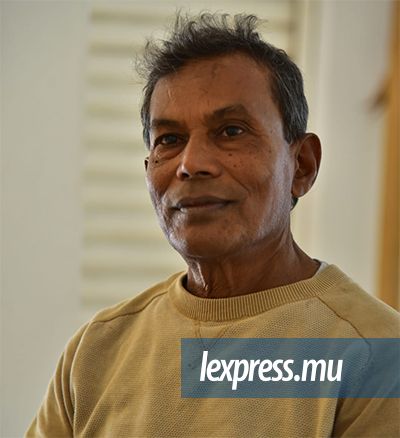The statue of Sir Anerood Jugnauth was unveiled at the Port-Louis Waterfront a week ago, on Saturday June 15. Since then, an avalanche of criticism has fallen on the work of sculptor Devanand Bungshee. In his workshop-gallery in Pointe-aux-Piments, the artist explains that the resemblance with the model and the «body language» of the statue were of paramount importance.
Devanand Bungshee is the Mauritian artist who has been most severely criticized over the past week. Since the unveiling of his statue of Sir Anerood Jugnauth at the Port-Louis Waterfront on Saturday June 15, the resemblance – or not – of the work with his model has triggered an avalanche of comments.
The less flattering believe that the face of the statue does not exactly recall that of the former Prime Minister and former President of the Republic. What’s more, the late father of the current Prime Minister, who unveiled the statue, with his family. On the other hand, that the work is afflicted with a certain stiffness, with the arms placed alongside the body. The most jeering underline the quantity of public money spent by the Ministry of Arts and Cultural Heritage, for a statue which does not meet with unanimous approval. If the budget allocation last year for the erection of monuments item was Rs 15 million, sources indicate that the statue would have cost Rs 13.5 million.
Imposing presence upon entering Devanand Bungshee’s studio-gallery in Pointe-aux-Piments.
We pause at the entrance to Devanand Bungshee’s studio-gallery, the Ananta Art Gallery, in Pointe-aux-Piments. An imposing statue wrapped in plastic waits. Her legs are buried in the floor of the gallery, a meter below us. The sculptor confirms. Yes, it is indeed the clay and plaster of Paris mold of the bolom statue. This mold will be destroyed, says the sculptor. “This clay will be recycled.”
Met on Thursday, June 20, Devanand Bungshee took the precaution of explaining at length that he must respect the confidentiality clauses of the Ministry of Arts and Cultural Heritage. He is very reluctant to reveal the mold used for the bronze work, which joined the statues of Sir Seewoosagur Ramgoolam and Professor Basdeo Bissoondoyal at the seafront last week.
The sculptor explains that the statue represents SAJ as he was between 60 and 65 years old.
But the desire to explain his work and respond to detractors ultimately won out. “Art criticism is acceptable. For example, if it’s another artist with his vision and experience who critiques my work and that helps me improve, that’s fine. There will be a debate around art, parski kapav monn fer enn erer.” On the other hand, for Devanand Bungshee, “when it is the laymen who have never seen how a statue is made, who have no notion of art, who criticize, I ignore them. Zot koz ninport». Draped in his dignity, the sculptor quotes Shakespeare: «what great ones do, the less will prattle of»a replica of the play Twelfth Night.
Cracks crack the soft material of the clay mold. Proof that time has passed since the Ministry of Arts commissioned the SAJ statue from Devanand Bungshee, “around the end of December 2023”. The required size: a bronze statue 3.6 meters high which is placed on a cut stone base, the creation of which was “subcontracted to a stonemason”indicates the sculptor.

After explaining at length that he must respect the confidentiality clauses of the Ministry of Arts, Devanand Bungshee agrees to reveal the clay and plaster of Paris mold of the SAJ statue.
The statue, demands the ministry, must also show SAJ’s posture when he was standing, with his hands on both sides of his body. As for the physiognomy of the statue, “the ministry provided me with around ten photos”. Specification: The statue must represent SAJ “neither too young nor too old. The statue shows him when he was around 60 to 65 years old., specifies the sculptor. Added to this, the sculptor claims that he did his own research, that he consulted “photos and videos on Google, to arrive at the similarity with the model. The resemblance is very important. It’s the same technique that I use for all the statues of people who have existed, that I have made”.
Having the clay mold almost at eye level – which is impossible on the seafront – shows a face with a half-smile. «Tro serie li pa bon», said the sculptor. A smiling face, «sa li pou donn enn pli bon mesaz»explains the artist. “In several photos of SAJ that I have studied, he displays this smile.” Devanand Bungshee recalls that the model of the statue was “worked for the development of the country. The statue had to reflect his personality.. Did it also translate a form of authority? “Yes it’s important. Even if you can’t fully see someone’s face, their body language says a lot.”
The SAJ statue took six months of work. What took the longest? It is with the head that the sculptor begins, by shaping the face on a turntable. A 3D work based on a study of photos taken from various angles. “You have to step back, correct, start again, that’s why it took about a month of work just for the head.” The statue looks straight ahead. “It was in SAJ’s personality.”
The clay mold is held together by an iron frame. The next two months after making the head were used to shape the rest of the body out of clay. Next step: molding the plaster which becomes the negative. The plaster is coated with “12 millimeters of wax for 12 millimeters of thickness of bronze”. This is the lost wax technique. The interior of the bronze statue is hollow.
The technical foundry process follows, in the oven fueled by a wood fire for 48 hours, to evacuate the water which is in the plaster. And melt the wax. In another coal-fired furnace, bronze is melted in turn. “It took three tons of bronze for the SAJ statue. About 12% of the material becomes waste because it is burned. It’s like the jeweler’s.”
The bronze statue was not cast in one piece. For SAJ, there are ten parts including the bronze base which is placed on the cut stone base. The parts were assembled using bronze welding. At each step, “there are four to 12 people who worked”, brings out the sculptor. For the patina, a brownish color was chosen. Contrasting with the black patina of the statues of SSR and Professor Basdeo Bissoondoyal.
The SSR statue is Devanand Bungshee again
Record attendance at the Port-Louis Waterfront for sculptor Devanand Bungshee. He has three statues in a row to his credit. In addition to SAJ, it was he who created the statue of Sir Seewoosagur Ramgoolam which is next to his work unveiled on June 15. Next to the statue of SSR, that of Professor Basdeo Bissoondoyal, it’s him again.
In addition to SAJ, the sculptor also shaped the faces of SSR, Sir Satcam Boolell, Sir Veerasamy Ringadoo, among others.
Facing the seafront, several of his works populate the Place d’Armes. The statue of Sir Satcam Boolell is by Devanand Bungshee. Just like that of Sookdeo Bissoondoyal. He also created the bust of Doctor Maurice Curé and that of Sir Veerasamy Ringadoo.
In the Company Garden, the monument representing the planisphere of the Arab cartographer Al Idrissi was created by Devanand Bungshee.
At the Vacoas bus station, he signed a statue of Pandit Sahadeo.
The sculpture garden project

The workshop-gallery where the artist patiently creates a sculpture garden.
A sculpture garden is being developed behind the Ananta Art Gallery in Pointe-aux-Piments. This is Devanand Bungshee’s lifelong project. From flat land, he made it into a space with gentle rises and slopes. Corners in the shade of a huge banyan tree. “This tree is beautiful, but the downside is that nothing else grows underneath it.” Devanand Bungshee has already assembled a nursery that he plans to plant as his sculpture garden flourishes. A waterfall is coming, he announces. Just like spaces dedicated to the history of Mauritius, with a nod to slavery, another to indentured labor. At the bottom, a concrete dome represents the shape of an octopus, “but not with eight legs otherwise visually it would be heavy”.
Another piece of history in the Devanand Bungshee Sculpture Garden.
Career path: from teacher to self-employed
Devanand Bungshee trained in fine arts at the Maharaja Sayajirao University of Baroda in India. After his studies, he taught for 16 years in the fine arts department of the Mahatma Gandhi Institute, from 1985 to 2001. “But we can’t have our feet in two boats”he replies when asked why he resigned as a teacher after 16 years of career. “I wanted to have more freedom.”
What further motivated him to devote himself to sculpture was that at the same time he received the order for the statue of SSR which is at the Port-Louis Waterfront. Other orders follow. “I had already taken leave from MGI to fulfill these orders. It was no longer possible to continue like this.” But above all, the artist derives more satisfaction from the creation of these works than from the routine of a teacher.

After 16 years as a teacher at MGI, Devanand Bungshee resigned to sculpt full time.










